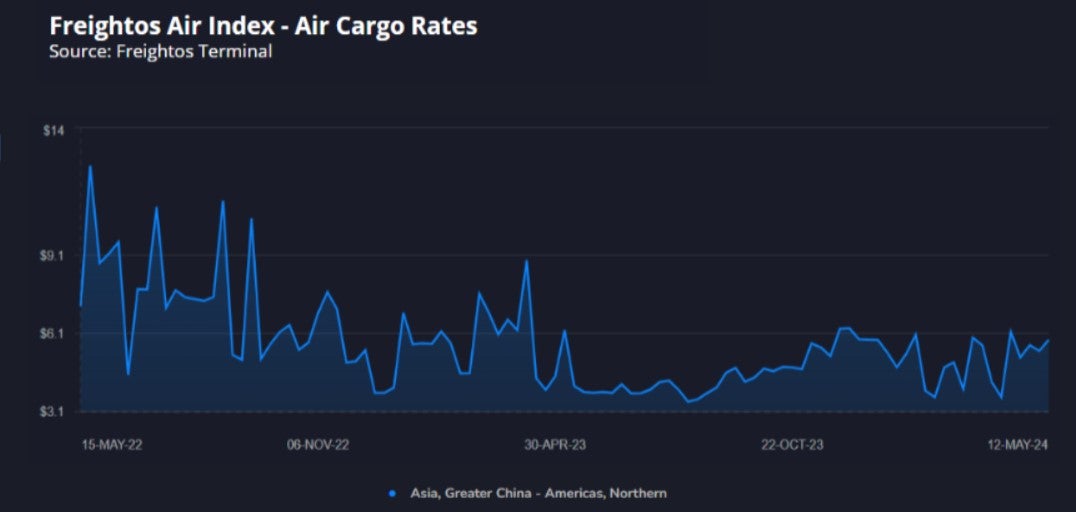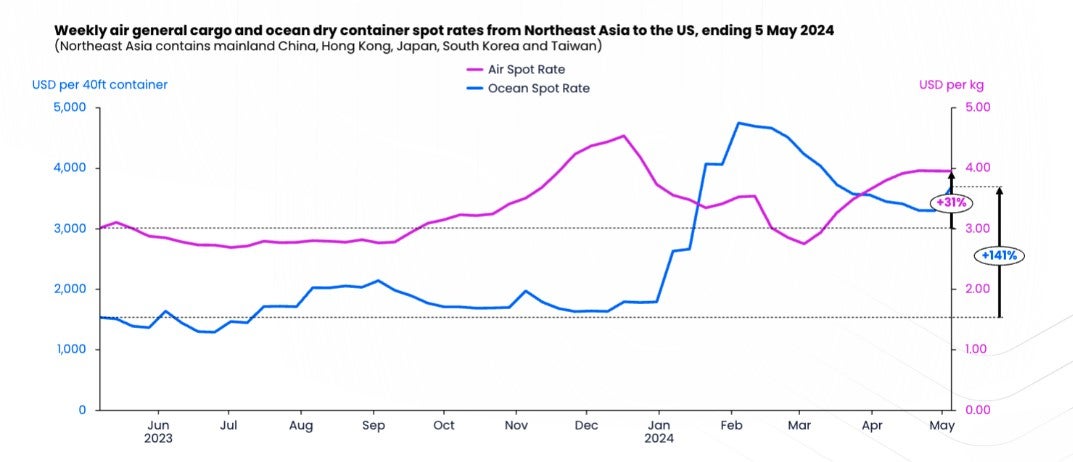Global airfreight volumes didn't subside after China's Lunar New Year holiday in February, as many industry professionals anticipated, and are still going strong, albeit with ebbs and flows. The primary catalysts remain Asian exporters shifting modes because of slower ocean transits around the Red Sea conflict zone and robust bookings by Chinese e-commerce platforms fulfilling orders in Europe and North America.
Air cargo demand grew 11% year over year in April — the fourth month in a row that has happened, according to rate benchmarking platform Xeneta. The International Air Transport Association, widely followed by the broader public, also reported lagging data showing volumes grew 10.3% in March and 13% during the first quarter. Sector volume has increased by double digits for five consecutive months, cementing the recovery trend from a steep downcycle that began in 2022.
And the momentum has carried over into early May with volumes up 12% to 16%, the latest data from WorldACD and Xeneta show.
Demand growth for air transport has tapered slightly in the Indian subcontinent and Southeast Asia as ocean shipping schedules around the Red Sea conflict have become more predictable and cargo owners order goods with longer delivery times in mind, but volumes are still significant by historical standards. A short dip in April related to the Muslim Eid holiday and flooding at Dubai airport was replaced by a surge in flower volumes from Central and South America.
North America is the primary destination market for flowers shipped by air, consuming more than 60% of all flowers flown from Latin America and Africa combined, WorldACD said.
Colombia-based Latam Airlines, for example, said it moved more than 24,000 tons of flowers in the three weeks leading up to the Mother's Day holiday, marking a 20% increase compared to the same period last year. Volumes out of Central and South America are now coming down with the passage of Mother's Day.
The improved business climate is reflected in cargo revenues reported by airlines for the first quarter, with year-over-year declines much narrower than every quarter last year. Air France-KLM's cargo revenues, for example, declined 16.5% compared to 23% in the fourth quarter and saw a 29% drop for the full year against 2022.
A year ago, global airfreight rates were about 45% lower than in 2022. Today, cargo spot rates are about even with the prior year for the first time since August 2022, rising 5% y/y to about $2.50 per kilogram.

The China-North America spot rate reached $5.86/kg on May 12, up about $1.80 from 12 months prior.
At the same time, cargo capacity has increased about 5% y/y as passenger airlines throw more aircraft into action for their big summer schedules, decreasing load efficiency by 3 points to 59%, said Xeneta.
Asia-Pacific air exports remain particularly robust with volumes up 13% in April (but only flat compared to 2019). And after a post-Lunar New Year dip, spot rates on the eastbound corridor from northeast Asia to the U.S. have rebounded by more than 30% y/y, according to Xeneta. Meanwhile, air shipping prices out of the Middle East and southwest Asia are up 42% y/y because of the longer ocean transit times around Africa.
Nontraditional sources of demand
Xeneta's April report indicated the air transport spillover resulting from elongated ocean routes to Europe is beginning to ease as businesses plan longer lead times, but tonnages out of the Middle East and Indian subcontinent are still two to three times higher than last year. Nonetheless, air and sea-air alternatives are increasingly attractive alternatives as conditions in the ocean market shift again.
The ripple effects of rerouting around the Horn of Africa, along with increasing demand in Europe, have led to vessel bunching and congestion at hub ports in Asia and capacity shortages. The container shipping industry will suffer a 15% to 20% loss in capacity on the Far East to Northern Europe and Mediterranean corridors during the second quarter, shipping line shipping giant Maersk estimated in a market update last week. It also said vessels are forced to lengthen their journeys as rebel attacks have reached farther offshore.
Meanwhile, ocean carriers are rolling cargo from week to week as they adjust vessel schedules to maximize operating efficiency, leaving containers sitting on the dock for one or more weeks.
The combination of continued demand, skipped port calls and forecasts for indefinite Red Sea diversions has jacked up ocean freight rates, especially on the Far East westbound corridor from Asia to Europe.
Shipping prices from Shanghai to Rotterdam, Netherlands, increased 20% week on week, to $3,709 per 40-foot container, according to Drewry's World Container Index, while Xeneta showed a 15% week-on-week increase. Ocean carriers are also implementing hefty peak season surcharges months before the traditional peak season on key European trade lanes.
The average air cargo spot rate on the trans-Pacific trade lane is just under nine times greater than for a 40-foot container compared to 22 times higher at the start of December, before Houthi rebels escalated attacks on Red Sea shipping, Xeneta said in a May 10 blog post.

Source: Xeneta
Businesses are willing to accommodate extra shipping time on the water for lower-value commodities, but for European cargo they increasingly opt for sea-air service via hubs like Dubai and Sri Lanka to move electronics and other high-margin goods, said Kathy Liu, vice president of sales and marketing at Taiwan-based freight forwarder Dimerco Express, on the latest episode of The Freight Buyers' Club podcast. There has also been a notable increase in use of the China-Europe railway and its 14-to-16-day transit times, she added. And U.S. and European companies that must avoid Russia and Iran to comply with sanctions for the war on Ukraine can utilize an alternative rail route that takes about 30 days.
Sea freight diversions around Africa have led to a doubling of outbound India air cargo rates since January. But prices recently leveled off at about $5.40 per kilogram to North America and $3.90 per kilogram to Europe, according to the Freightos Air Index, suggesting that the ocean shipping situation may be improving even as some volumes are still pushed to air.
The question for the industry is whether demand will hold up until the busy shipping season gets underway in September.
Two product categories, e-commerce and e-cigarettes, show no signs of slowing as they continue to dominate the market out of China. Fast-fashion maker Shein, as well as marketplaces such as Temu and AliExpress, have become so popular year-round that they don't have a low season like most retailers do, said Liu.
In fact, business-to-consumer shipping has become the driving force for the air logistics sector at a time when traditional business-to-business shipments managed through freight forwarders are lagging. E-commerce's impact on the industry is illustrated by the fact e-commerce represents 50% of all volume leaving China, according to Dimerco's latest monthly update.
Lui said that 70% of air exports from Hong Kong and half of volumes flown out of Shanghai are small parcels.
Aircraft space is constrained at regional transit points because so much of the airfreight capacity leaving China is already occupied by e-commerce shippers, Liu added in remarks to FreightWaves. The second leg of freighter flights operated by Singapore Airlines SINGF, China Airlines and Evergreen International Airlines, for example, that originate in China are already tight when they connect in Singapore and Taiwan on their way to Europe and the United States, which is pushing up freight rates in those locations.
Dimerco also reports that Temu has begun using sea-air products in which parcels move by container vessel to ports in Taipei, Tokyo and Seoul, South Korea, and are then transferred to nearby airports to be placed on aircraft bound for the destination market. As a result, freight rates in those locations now exceed those from mainland China, it said.
Logistics professionals say the market power of the big e-commerce sellers is forcing traditional customers to order and ship earlier in the year to ensure they aren't scrambling for capacity at the last minute, which could mean more volumes are pulled forward during the summer that otherwise would go in the peak season.
Although large space allocations out of China are difficult for some forwarders to secure because of activity by Chinese e-commerce sellers, analysts say airlines will not commit all their capacity now because "they can possibly get up to 50% more revenue for that same capacity in the short-term market" during the fourth quarter, said Niall van de Wouw, Xeneta's chief airfreight officer.
Xeneta said it sees a slight trend in which logistics providers are moving out of spot rates, which are only valid for a few weeks, into short-term contracts that insulate against rising rates but also retain more flexibility for reacting to unexpected events than long-term contracts can.
Economic conditions tilt positive
Macroeconomic factors remain generally favorable for air cargo, despite some cautionary notes, leaving air logistics professionals optimistic about a robust fourth quarter.
The global manufacturing sector has slightly expanded since the start of the year, while new export orders are near the threshold for growth. The order-to-inventory ratio has continued to rise this year, supporting logistics demand, according to the Institute for Supply Management. And the World Trade Organization this week said it expects global goods trade to increase 2.6% this year after falling 1.2% in 2023.
European companies appear to be in a restocking phase after cautious ordering last year led to a reduction in inventories, said Maersk CEO Vincent Clerk in a recent earnings call with analysts.
On the flip side, inflation in the United States is still running hotter than expected, delaying anticipated rate cuts by the Federal Reserve, and consumer confidence is ebbing. Inflation is also ticking up in other parts of the world.
Seaborne imports of containerized freight slowed in April, rising 8% year over year after a 16% jump in March, according to S&P Global Market Intelligence. The slowdown was driven by consumer durable goods, such as home furnishings and appliances. Although ocean and air freight markets are interrelated, those types of products typically don't move by air, and e-commerce dynamics suggest air cargo demand won't mirror ocean shipping trends.
Investment bank Morgan Stanley has trimmed its intermediate-term outlook after U.S. GDP growth for the first quarter fell below estimates at 1.6%. Morgan Stanley says the odds of a hard recession have increased to 25% to 30%. A mild recession looks like a 50% probability now. Then again, economists forecast a recession last year that never materialized.
"We are quite confident for the coming months regarding demand for the market" said Liu, summing up the feeling of many forwarders and airlines.
But absent demand from China-origin e-commerce and ocean shipping diversions, and with weak industrial production, it's unclear if other heavy freight categories in the rest of the world are experiencing any growth, some analysts say.
The post Airfreight rides e-commerce to surprise growth in May appeared first on FreightWaves.
© 2025 Benzinga.com. Benzinga does not provide investment advice. All rights reserved.
Trade confidently with insights and alerts from analyst ratings, free reports and breaking news that affects the stocks you care about.